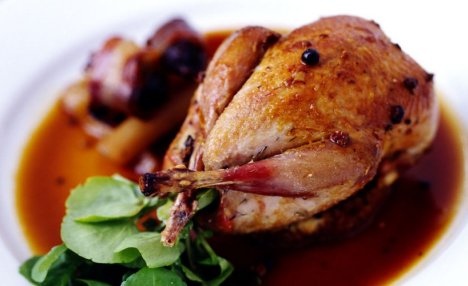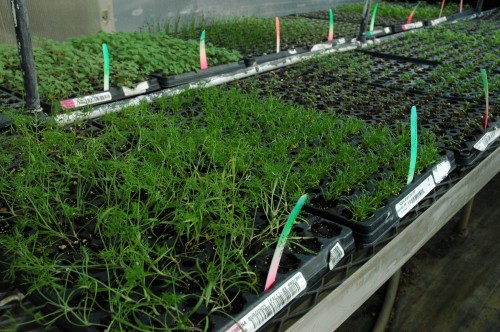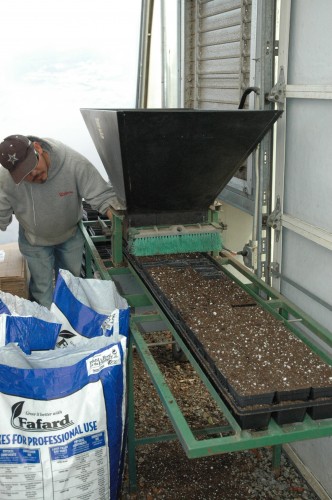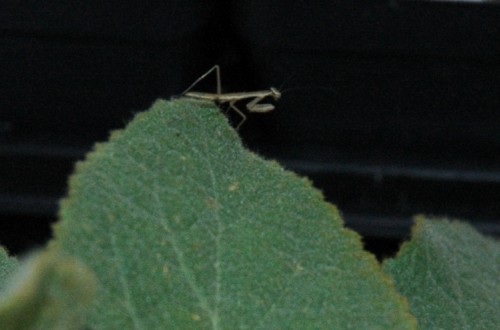by Briscoe White | Dec 10, 2010 | Life on the Farm, Miscellaneous |

Now that fuel prices have risen to such high prices, heating a greenhouse has become an economic hardship. For twenty years we happily burned LP gas for heat and felt we were not only economical but also being kind to the atmosphere. As fuel prices began to increase a few years back, we began to explore new fuels to heat our greenhouses.
Being in a rural county in which logging is the second largest industry after farming, we knew wood was our fuel of choice. It requires some work, but wood costs have been about twenty percent of LP gas cost. The two things we had to get used to was stoking the furnace and getting used to the blue- black column of smoke rising from the nursery. It was hard for us to believe wood was more environmentally friendly than gas, which makes no visible exhaust.
Further research found on the Office for Resource Efficiency website, has proven that wood is better environmentally even if it does look worse. Wood carbon is already here with us where as fossil fuels are adding carbon that has been in deep storage for eons. LP gas is methane that is about twenty five times the greenhouse gas carbon is. Gas escapes to the atmosphere from the well to pilot lights and reeks havoc in the atmosphere. So even though it stinks and our clothes smell like wood smoke, it is the better fuel.
Lastly we had to reconcile our love of trees with the huge piles of wood we burn. We worked out a deal with a local logger where they cut the slash for us. Slash is the limbs and smaller trees that are normally left in the woods, so we feel we are not responsible for cutting trees just for us. This is not a perfect system but it does remind one of the old days. Fuel is cheap, so turn up the heat!
by Briscoe White | Dec 6, 2010 | Herbs, Life on the Farm, Recipes |

On the First Day of Christmas, if your true love gives you a partridge in a pear tree here’s how you can prepare it! Using a variety of our fresh herbs here’s a modern twist on a traditional dish that has become one of our favorites!
Roasted Partridge with Pear Salad
Serves 2
* 2 Partridges
* 5 Celery Stalks
* Sea Salt
Soak
* 4 Cups of Hot Water
* 1 Fresh Bay Leaf
* 1 Tsp. of Fresh Thyme
* 1 Sprig of Fresh Rosemary
*5 Chopped Fresh Garden Sage Leaves
* 1/4 Cup of Sea Salt
* 1 Lemon or Lime for Juice and Zest
Sauce
* 2 Tbs. Unsalted Butter
* 3 Tbs. Demi-Glace (store bought, or use our Bouquet Garni Kit to grow and make your own!)
* 3 Tbs. Apple Brandy
* 1 Tbs. Cider Vinegar
* 1 Minced Shallots or Chives
* 1/4 Tsp. Cinnamon
* Sea Salt to taste
1) Combine ingredients for soak with 4 cups of hot water. Stir and let cool to room temperature.
2) Once cooled, submerged partridges in soak mixture and refrigerate overnight.
3) Once refrigerated, preheat oven to 425 F degrees and pat partridges dry. Let sit and warm to room temperature for 25 minutes.
4) Stick 1/4 of a lemon or lime (or for a less acidic flavor, try using fresh Lemon Verbena) into each of the partridges. For a saltier taste, add a pinch of salt to each bird, otherwise the soak will have made them somewhat salty.
5) In an oven-proof pan, make a bed of the celery stalks in the bottom of the pan to lay the partridges on top for roasting. Oven roast for 35 minutes. Make sure meat in the center of the bird is around 155 with a meat thermometer to avoid illness.
6) Remove the celery and partridges from the pan and melt butter over medium heat. Saute shallots until slightly brown and add the ingredients to make the sauce. Stir well to combine each ingredient and let simmer until well cooked through, before turning off the heat completely.
Pear Salad
Serves 2
* 2 Asian Pears
*1 1/2 Cup of Walnuts (You can also used candied walnuts)
* 1 Cup of Goat Cheese
* Arugula, add more or less to your liking.
1) Wash and shake Arugula dry and add to bowls.
2) Dice pears and sprinkle over Arugula.
3) Add walnuts and goat cheese to your liking.
by Briscoe White | Dec 2, 2010 | Growing, Herbs, Life on the Farm, Miscellaneous |

Our seedlings are growing strong to ship to your door!
Temperatures are dropping outside and everyone is gearing up for the holidays, but here in the greenhouse, we’re thinking only of spring! Our slow-growing seedlings have been germinating and getting ready for weeks, and they’re just about ready to transplant and stretch their young roots. With help from our flat filler, thousands of new seedlings will soon move on up to their bigger pots!

Ino working hard in the greenhouse!
Slow-growing plants like Chives, Feverfew, White Sage and Vervain can take weeks, months, or even years (if it’s Bay) to mature enough for transplanting. Here at the Grower’s Exchange, we take our time with our young seedlings, patiently watering and waiting for the day when they can ship out to your door.
These little plants will be waiting and ready to be added to your garden in March. Stay tuned for growth updates!
by Briscoe White | Nov 30, 2010 | Gardening, Life on the Farm, Wildlife |

One of our smallest employees at The Growers Exchange!
Our babies have arrived! Our Praying Mantis eggs have hatched! For those of you who didn’t catch our previous blog on natural pest deterrents, we collected Praying Mantis eggs from the cedar trees we use as a wind break and placed them in our greenhouses. While looking at the Comfrey today, we noticed the little Mantises crawling all over the leaves! We looked at the egg sac above the Comfrey and it had hatched. We even found one with a small beetle! Great work little guys, we’re glad to have you on our green team!
Speaking of Comfrey, we have lots that are now going dormant but still have strong root structures. These plants will establish over the Winter and appear in Spring as much bigger plants. For any gardeners still looking for Comfrey this season, we’re putting them on sale soon so keep an eye on our site– and we know they’ll be bug free because we have our little friends tending them!
by Briscoe White | Nov 12, 2010 | Life on the Farm |

A sick horse is no joke. That’s a whole lot of animal to take care of, which usually means a whole lot of money and time spent dressing and caring for your four legged patient. Recently, my wife’s Quarter Horse, Poco, developed a wicked looking abscess on his stomach. Since we live out in the middle of nowhere, it’s not easy or cheap to get a Vet to come out and visit in a timely manner, so we had no idea what to do.
We remembered a five time recommended topical spray from Horse Quarterly that was supposed to be a great natural cure for skin irritations and lesions, so we gave it a try. Within the first three days, this miracle spray had Poco feeling much more like himself! The spray is an all natural topical ointment used to help soothe sores and boost an animal’s natural ability to heal. The only ingredients in the spray are Canola, Lavender, Eucalyptus, and Tea Tree Oils, which got us thinking about the healing properties of the herbs we grow.
For centuries, people have used herbs like Agrimony, St. John’s Wort, Chamomile and many others for medicinal purposes to cure everything from allergies to arthritis, many of which we actually grow here and sell through our website. So, the next time you or your pets are feeling a little under the weather, see us instead of the pharmacy. Herbal remedies are a lot better for your body AND your wallet! (more…)
by Kenan White | Aug 18, 2010 | Exploring, Life on the Farm |

My son just brought this spring nest to my attention – the birds have fledged and are now moving freely around the farm. Their nest, a home that they shared for months, is all that is left. When you really look closely, you can see how industrious these birds really are.
Not far away is the pasture for my wife’s horses – inside the barn, where she grooms them, is an apparent Home Depot for building supplies. Upon close inspection, much of this nest is made out of horse hair – the hair from the tail and mane that is extremely durable and has been used throughout history for a number of uses: paint brushes, upholstery, musical instruments, fishing line. I paid a pretty penny for a great looking horsehair belt.
We think the nest was made by a Jenny Wren but can’t be sure … are any of you gardeners out there ornithologists? We’d love to settle some bets around the office.







